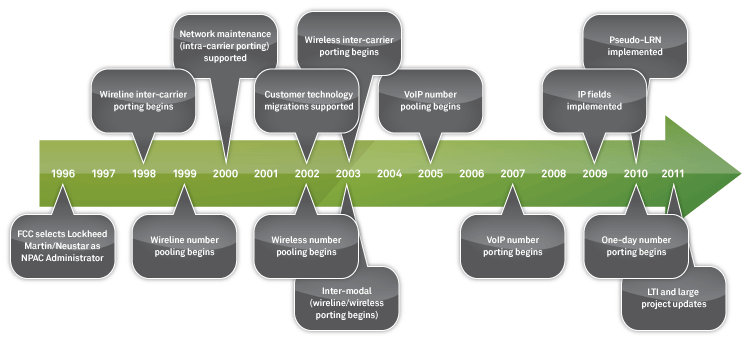About the NPAC
The Neustar NPAC System is part of the infrastructure for the telecommunications industry, providing the portability that supports the continued convergence of wireline, wireless, voice over Internet protocol (VoIP) and IP communications.
The Canadian NPAC has been administered by CIS-Lockheed Martin, and then Neustar, since its inception in 1996. Read more about the NPAC, including why it exists, how it supports the ever-evolving telecommunications industry and its impact on our everyday lives.
History of the NPAC
The Telecommunications Act of 1996 mandated Local Number Portability ( LNP ) in the U.S. to enhance local telephone service competition. CIS Lockheed Martin was awarded the initial contract to develop and administer four of the seven U.S. regional NPACs. Perot Systems was awarded the contract to develop and administer three U.S. regional NPACs and the Canada NPAC. Both vendors worked to prepare for the FCC-mandated national rollout scheduled to begin in October 1997, with completion by December, 1998. However, Perot Systems was unable to build a stable platform and meet the implementation dates. Consequently, CIS Lockheed Martin, now Neustar, was awarded the remaining U.S. NPACs as well as the Canada NPAC that was awarded by the Canadian LNP Consortium Inc. The U.S. NPAC transitioned to another company, iconectiv, in May 2018.

Scope of the NPAC
The Canadian NPAC brings together telecom carriers throughout Canada, providing a level of standardization, efficiency and cost-savings that is unrivaled in the world. The NPAC enables more these telecom carriers to securely and cost-effectively route phone calls and transfer customer telephone numbers among carriers.
The Canadian NPAC system plays a vital role for every consumer of telephone and communications services by letting them choose providers based on price, quality, and service. For every communications service provider, the NPAC system provides fair, equal, and secure access to essential shared data and resources.
Reliability and Value
The NPAC has a solid record of high reliability. Its modular infrastructure enables Neustar to expand capacity and add capabilities with incremental investment and without service interruption or quality of service degradation. Over the past 20 years, Neustar has successfully implemented eleven major software releases and continuous infrastructure upgrades.
The Services Management System (SMS) database at the core of the NPAC stores and relays an enormous amount of critical data that is fundamental to the operations of the telecommunications industry in Canada. Carriers use the NPAC to publish how they want to interconnect with each other, and depend on it to ensure secure transactions with competitors. The success of the NPAC rests on its inherent neutrality in securely storing and sharing this information efficiently and appropriately.
To insure the integrity of the NPAC database that is shared and used by competing carriers and other providers of telecommunications-related services, access and use is limited .
Today’s NPAC
As the industry has continued to evolve, so too has the NPAC. With a history of delivering innovation to support new mobility, VoIP and carrier wholesale number portability, today’s NPAC not only meets its original mandate for wireline number portability, but also supports intermodal porting between wireline, wireless, and other types of services supported by local number portability.
The NPAC enables cost-effective capacity expansion without interrupting service or degrading its quality. As communications grow increasingly rich for consumers and more complex for carriers, the NPAC is designed to continue cost-effectively support the evolving needs of the telecommunications industry.
